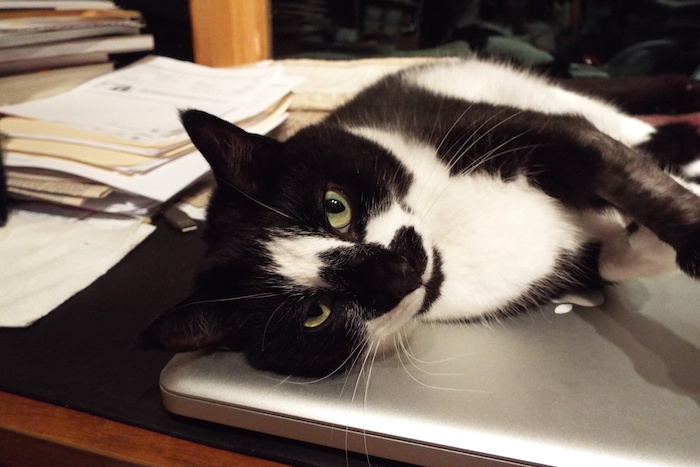If kittens don’t receive appropriate handling and socialization early in life, they can develop undesirable habits. Here’s how to help tame their behavior.
Mollie was turned in to the shelter when she was approximately 4 weeks old, a singleton with no mom in sight. She languished in a cage until we saw her photo posted, visited her, and began adoption proceedings.
She was tiny and we had to wait to bring her home until she reached 2 pounds and was spayed. In the meantime, she came down with calicivirus, which further delayed the adoption. In the shelter, she was sweet and docile, except when it came to the claw-clipping test, when she turned into a dervish of claws and teeth. We put that on the back burner to avoid stressing her and jeopardizing our budding relationship.
With all that, she was 3 months old by the time we brought her home. Even though Mollie adapted well to the household and our other cats, it became evident that she had missed a few lessons in Socialization 101.
Ideal Kitten Development
The optimum period for kitten socialization is 2 to 7 weeks but it may continue through 14 weeks. Moms and siblings are the best teachers.
Human handling is important, too. Kittens should be touched or handled regularly by various people for as little as five minutes a day and exposed to various household situations and sounds, such as the big bad vacuum cleaner.
A kitten raised in a crowded shelter, separated from her mom at an early age, or cared for by a feral mom, may need some remedial socialization–and some patience. She may hide when first brought into the household. She must learn to temper play aggression: the use of teeth and claws to play with hands and ankles. She may need help getting acquainted with proper litter box etiquette. She may squirm when being picked up.
Take heart. With careful observation and interaction, the result can be a loving companion.
Redirection, Reading, and Group Play
Sara Russell, KPA CTP, CPDT-KA, of the International Association of Animal Behavior Consultants (IAABC), recommends hands-off interactions such as using wand toys to redirect kitten energy.
“I also recommend paying attention to when the kitten is typically in play mode and focusing their energy on playing with them before the kitten starts going after the humans in the house,” she says.
Russell adds that these kitties can become overstimulated when handled. She recommends plenty of play before petting. Watch for signs of overstimulation and stop petting or handling before the kitten becomes aggressive.
When working in cat rescue, Elizabeth Gallagher-Pribula of IAABC says she began reading to both kittens and older feral cats in the bathroom to get them used to her proximity, her voice, and her energy. It helped, but the time frame for feral cats to respond was much longer than for kittens. One older cat could be touched and picked up after two months, while another took eight years.
Kindergarten classes, best for kittens 7 to 14 weeks old who have had their first shots, are still a novelty in many areas, but they offer exposure to other cats, people, and environments in a controlled environment.
Mollie’s Milestones
So how does this translate to Mollie?
While she doesn’t play aggressively, she can be quick with the claws and teeth, and even after nine years we still occasionally miss her signals. She resists being picked up and cuddled. It’s still impossible for me to clip her claws. Various desensitization techniques just haven’t worked, but fortunately she’s good at using her scratching post.
Mollie reacts to “stranger danger” – the lawn guy, delivery trucks driving up the driveway, Uncle Boom-Boom (my carpenter-brother) – by growling and running to hide in the kitchen cupboard. She also hides there during fireworks and thunderstorms.
In spite of those quirks, she’s a happy girl. She purrs readily when petted and loves to be near us. She keeps me company on my desk during the day and hangs out on the back of the couch in the evening, kneading her blankie and reaching out to “rake” my hair. She’ll throw herself into my path and wriggle and squirm, exposing her belly.
She also loves to sleep under the covers against my stomach and thighs and will stay in bed with me while I read or until I leave. But don’t attempt to reach in and pet her under the covers; I have a fresh slice in my finger as evidence.
Acceptance of your cat’s unique personality is key, as well as time and patience. Well-known cat expert Jackson Galaxy is quick to point out that many problems with cats are the result of unrealistic human expectations–and that goes double for a kitty born into a less-than-optimum environment. Encourage the behavior you see they enjoy and learn what triggers undesirable reactions.
Even better, seek help from your veterinarian, a veterinary behaviorist, or a qualified cat behavior specialist to help treat your cat’s fear, anxiety, and stress related to sounds, new objects or people, or whatever else frightens her. Much more is known now about cat behavior and ways to modify it for the benefit of your cat and yourself. Nobody wants to go through life being fearful if they don’t have to, including cats.
Occasionally, I scoop Mollie up from where she is resting and hold her close to me, nice and secure, rubbing her neck and head. She purrs. She can’t help herself. After a few seconds, she wants to get down and I let her go. Maybe someday she’ll relax into my arms.
This article was reviewed/edited by board-certified veterinary behaviorist Dr. Kenneth Martin and/or veterinary technician specialist in behavior Debbie Martin, LVT.








